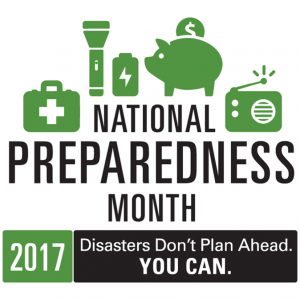 September is National Preparedness Month
September is National Preparedness Month
It’s not too late to take action to protect your small business, your clients and your employees from the threat posed by a disaster. The survival of your company is a key factor in the economic revival of your community in the aftermath of a disaster.
Here are a few things you can do to ensure safety in the midst of a storm, and shorter recovery in the long term.
Put together a disaster supply kit including a flashlight with extra batteries, non-perishable foods, one gallon of water per person, per day, a first-aid kit, medications, and extra cash. A complete list is available www.ready.gov. Consider the needs of your family, and those you are evacuating or sheltering with, when determining what else to include.
- Gather all that important paper—deeds/leases, title documents, insurance policies, financial records, inventory documents, personal documentation such as birth certificates and passports —and put them in a three-ring binder with pockets. Put that in a waterproof bag, and take it with you if you evacuate. You’re going to need these documents during the recovery phase.
- Backup your computer datain the cloud or on a flash drive.
- Make sure you have a plan in place to communicate with your employees and clients, to make sure that everyone is safe, and to let everyone know when you’ll be open again for business.
- Follow guidance on evacuation. If you are ordered to evacuate, know the routes to take, and have a plan on where to stay.
- Be safe. Download the FEMA mobile app (https://www.fema.gov/mobile-app) to set up alerts for the latest weather updates, shelter information, disaster resources and preparedness tips in English and Spanish.Once a disaster declaration is made, the U.S. Small Business Administration activates long-term recovery assistance to businesses of all sizes, homeowners and renters in the form of low-interest disaster loans.
For more information on SBA’s disaster assistance program, visit www.sba.gov/disaster.
Printed in OhioMBE – Sept. 1, 2017
Discover more from OhioMBE
Subscribe to get the latest posts sent to your email.
